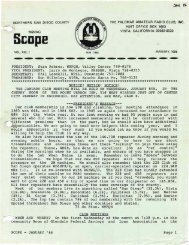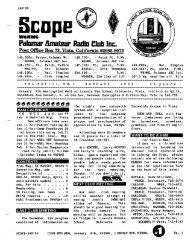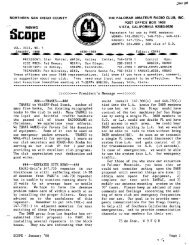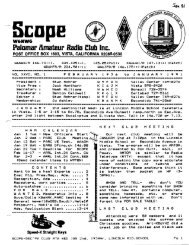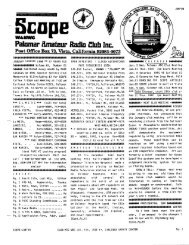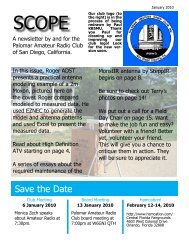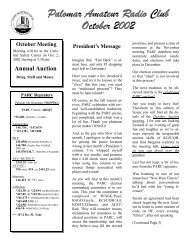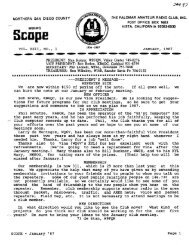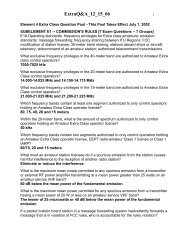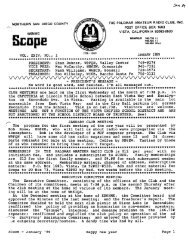You also want an ePaper? Increase the reach of your titles
YUMPU automatically turns print PDFs into web optimized ePapers that Google loves.
idge. A steep trail led up to the saddle<br />
at the top ofGoat Canyon.<br />
The trail deteriorated rapidly as the<br />
iescent quickened. We dropped over<br />
several dry fulls. Our first view of the<br />
trestle (from above) was at a large full<br />
which required us to climb up the side<br />
wall and basically slide down the slope<br />
to the bottom. From there the route was<br />
boulder hopping to the trestle which we<br />
reached about 11 :40. Here was a tank<br />
car used for fighting fires in the tunnels<br />
and trestles as well as a view of the<br />
portal ofthe old Tunnel 15, now leaning<br />
at a 15-degree angle. (The trestle replaced<br />
this tunnel.) The tracks on the<br />
other side ended at a landslide which<br />
completely covered Tunnel 16.<br />
After exploring the magnificent trestle<br />
from side and bottom, we continued<br />
under the trestle down Goat Canyon.<br />
Progress went well until we were almost<br />
at the bottom of Carrizo Gorge. when<br />
we encountered a high cliff blocking<br />
progress downward. After a bit of<br />
scouting a crack was discovered leading<br />
~down the cliff. John, having the foresight<br />
to bring a climbing rope, belayed<br />
Stan down, who verified the route was<br />
doable to the bottom. After belaying Bill<br />
down, John freeclimbed to the bottom.<br />
At 1:00 we headed down Carrizo<br />
Creek towards Glenn KE6ZLY and<br />
Barbara KA6FPS, who had hiked up<br />
Carrizo Canyon for a view ofthe trestle<br />
from the bottom. Meeting them just<br />
down the canyon, we all then proceeded<br />
to bushwack through thorny mesquite,<br />
tules, and other dense and thorny vegetation.<br />
A quick sidetrip to an Indian site<br />
and we were back at the car at 4:30 and<br />
back at camp just after dark.<br />
Glenn and Gloria stayed the night,<br />
while the others returned home - most<br />
stopping for a large milkshake and more<br />
cold Gatorade on the way.<br />
Not "a walk in the park" (although it<br />
was in the park), but a most interesting<br />
adventure and challenge.<br />
Known casualties: One HT, one pair<br />
pants, numerous cholla punctures and<br />
rock abrasions.<br />
Route length by map: 7 miles. <br />
Route length by foot: estimated 10 <br />
miles.<br />
Route length by time: 8.5 hours.<br />
Photos are posted at<br />
http://home.earthliDk.neU-wjj/golgoatc:yn<br />
73, BillAA6J<br />
(the Scope welcomes stories such a3 these IDst<br />
two which can be connected to amateur rodio<br />
in some way -Ed)<br />
Dial Tones<br />
In the old patch system, some ofyou<br />
sneaked around our directions and got:<br />
away with it. No More!<br />
In the old patch you were instruction<br />
to kill the patch with a # when the patch<br />
failed.<br />
Some of you, when the patch fuiled,<br />
saw that the dial tone was still up so<br />
without issuing a #, you quickly dialed<br />
the number again without the # and then<br />
the access code.<br />
This will no longer be possible. The<br />
computer will only process calls that are<br />
made up using your assigned PIN number<br />
along with the autopatch information<br />
direction sheet which can only be<br />
obtained via club meetings, e-mail, or<br />
self addressed envelope with the requested<br />
information attached.<br />
Answering machine messages at my<br />
QTH requesting PIN numbers cannot be<br />
answered.<br />
Expiration Date<br />
The new autopatch program has a<br />
section in it where it looks at your<br />
membership expiration date. H your<br />
membership has lapsed by a month, the<br />
computer is programmed. to KILL your<br />
autopatch call. Sorry about that!<br />
H you look at an old Scope label, on<br />
the upper right hand side are(were?) two<br />
numbers. For example 0506 0108<br />
The first number 0506 is your license<br />
expiration date of the year 2005<br />
and the 06 is the 6th month or June.<br />
The second number 0108 is your<br />
membership expiration date of the year<br />
2001 in the 8th month, August.<br />
When the computer sees 9909 of<br />
your membership number, it will KILL<br />
the autopatch!<br />
It is your responsibility to let<br />
W9FQN know when you have pg.7<br />
updated your membership date 1;~3<br />
although I will check the patch JIID.<br />
computer for those calls being<br />
killed and try to update them at least<br />
eveIY month ..ifyou have renewed!<br />
Patch Program<br />
Stan Rohrer<br />
W9FQN@Juno.com<br />
The computer program which controls<br />
the PARC autopatch system is<br />
written in QBASIC and is being run on<br />
an old 286 computer which leaves quiet<br />
a bit to be desired.<br />
The first program written years ago<br />
used to record on printed paper all the<br />
phone calls made on the PARC patches.<br />
Items printed were time in, time out,<br />
length ofcall, date, and phone number.<br />
This computer system was used in<br />
connection with the tape recorder system<br />
used by WB6lQSJohn in Vista.<br />
The first program was written by me<br />
with three lines ofcode contributed by a<br />
former member which allowed access to<br />
the RS232 port.<br />
H there appeared to be a problem on<br />
the repeater being used for the phone<br />
call, the printed sheet gave us the exact<br />
time of the problem and WB6lQSJohn<br />
was able to use the PARC tape system<br />
which records voices on one track and<br />
the time on another track to easily hear<br />
the exact conversation in question.<br />
Unfortunately, these systems had no<br />
way of recording on paper who made<br />
the call and if there was a question<br />
about who we had to consult the tape<br />
recording and call the phone number.<br />
The new computer system records<br />
many of the same items but now it is<br />
able to affix to the call being made a<br />
callsign, name, club dues expiration<br />
date, plus several other items in addition<br />
to most of the things previously<br />
recorded or printed.<br />
The tones are picked up by a<br />
BLACK BOX. changed into serial DC<br />
signals, fed to the computer's RS232<br />
port, processed, reformatted.. and sent<br />
out to the three autopatches: Vista, La<br />
Mesa, and Mira Mesa via the computer's<br />
printer port via another black<br />
box.



